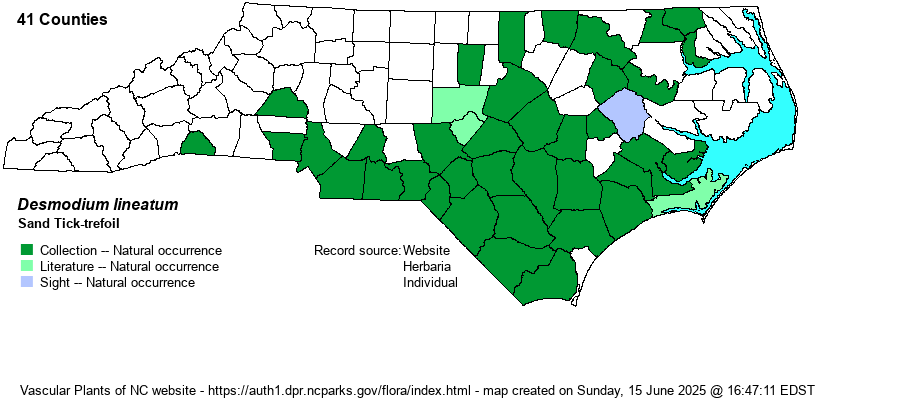| Author | de Candolle | |
| Distribution | Occurs throughout the southern half of the Coastal Plain, and present over most of the northern half as well, being absent only from the far eastern counties. Also ranges west into the eastern and southern Piedmont. Ranges west to Orange, Catawba, and Polk counties. Absent in the Mountains and the northwestern Piedmont.
This is a mostly Coastal Plain species, ranging north to MD, and south to southern FL and west to eastern TX. | |
| Abundance | Fairly common to often common in the Sandhills and eastward to about Craven County; mostly uncommon northward to the VA line, but probably absent in the far eastern counties. Uncommon in the eastern and southeastern Piedmont, west to Stanly and Union counties, but rare farther west. | |
| Habitat | This is a species of sandy soil, being most numerous in pine/scrub oak sandhills, but also found in open sandy woods and their edges, and other places with somewhat bare sand (though not in very deep sands). Readily found in fire-managed Longleaf Pine-wiregrass uplands. | |
| Phenology | Blooms from June to August, and fruits from August to October. | |
| Identification | This is an unusual species, being one of just several in the genus that crawls on the ground, though is not technically a vine. It has prostrate/trailing stems that reach about 2 feet long, but with quite small leaves for the genus. The scattered leaves (with 3 leaflets) are barely 1-1.5 inches long, with each leaflet being rounded and only about 3/4-inch long, about the size and shape of a fingernail. It does send up several scattered panicles of flowers, each panicle reaching about 10-12 inches tall, far surpassing the leaves. The many pink flowers are only about 1/5-inch across. Experienced biologists know the species well in the southern Coastal Plain. though many people might simply walk right past this small, trailing species without noticing it, unless the flowering stalks are visible. Nonetheless, this is a quite attractive "dwarf" plant, even without the flowers, not really looking like any other Desmodium, though a few Lespedeza species do creep on the ground. However, they (L. repens and L. procumbens) have glaucous blue-green leaves that are quite thin; D. lineatum has bright green to dark green leaves that are somewhat thick. | |
| Taxonomic Comments | None
| |
| Other Common Name(s) | Matted Tick-trefoil | |
| State Rank | S3? [S4] | |
| Global Rank | G5 | |
| State Status | | |
| US Status | | |
| USACE-agcp | | |
| USACE-emp | | |

